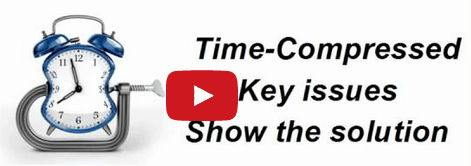Learn how we can help - Connect with a Trainer
All of our demo skills training programs are customized to your exact requirements.
We learn what matters most to you and then we craft a an experience that meets your needs.
We can deliver programs: on-site, on-line via live webinar or as self-paced e-learning.
Contact us to discuss your needs today.
"You should have seen the demo from Acme! Wow! We gotta get us some of that and fast!"

Video: Creating a Demo Story ..
To Succeed, a Software Demo Must be Memorable.
Ideally you want everyone who saw your software demo to tell everyone else what a great product you have and why they need to buy it!
I have seen way too many demos where the sales engineer says: "and another cool thing is..."
After the third cool thing, all features sound the same. No context. No Story. In our Software demo Training Classes we cover a number of ways to help with this problem, let's take a look at a few.
The Solution
Use a time-compressed software demo story structure for your demo. (Check out the video above for more detail on how to create a time-compressed story.) The key is that the story must illustrate how your product can take your prospect from where they are today to a much better place with your product. We call these stories "Now to Wow Stories". You will need an overall "Now to Wow Theme" for your software demo and you should use a "Now to Wow Story" for each topic that you cover.
Top 3 or 4 Issues
Using information that you gained in discovery, or during the demo, you will want to come up with the top 3 or 4 issues that your prospect is facing.
This step is critical to your success since missing an important topic leaves the prospect wondering if you can handle it and covering a topic they are not interested in wastes time and can make the demo and the product look more complicated.
Here's an example PDF Demo Form that you can use to help capture your prospects key issues.
A Time-Compressed Story
Your demo story needs to show how your solution solves the prospect's top 3 or 4 problems in the most concise, relevant and compelling way possible. In our classes and workshops we teach a technique called a "CRC Check" to show you exactly how this is done.
The Story should reflect the overall theme for the demo and and be comprised of "Now to Wow Stories" for each demo topic, compressed down to the essentials.
Be absolutely ruthless when it comes to cutting out unnecessary detail. If you are not sure if a topic is important, ask before you waste time on it.
As you do your research and discovery, always try to determine the most important problem for your prospect to solve and cover the topics in priority order.
To round out the demo structure, simply add a demo opening and a demo close.
The Demo Opening
The demo opening is typically a recap of what you believe their top issues are. If they have any changes or additions they will voice them at this time allowing you to add these changes to your demo. You also want to verify that the right people are present for the demo and that you have enough time. If a key decision maker is not available or has to leave early you may want to make adjustments to cover what is key for them or even consider rescheduling.
The Demo Close
The demo close can be as simple as asking for the next step in the sales cycle. In complex B2B sales this may be an evaluation or Proof of Concept or a formal proposal.
The Best Demo is Always the Shortest
Sometimes, there is one issue that is so severe to your prospect that if you can solve it nothing else matters. In this case the best demo may be one that shows how to solve that one problem, short and sweet, and nothing else!
Good Selling!
